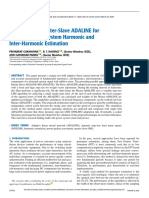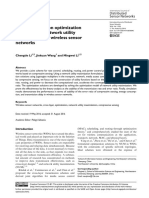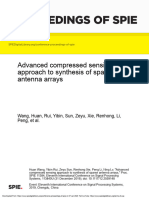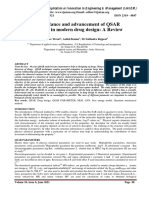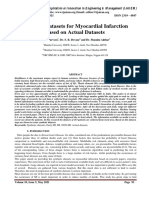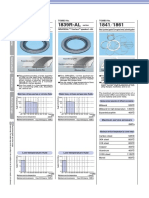0 ratings0% found this document useful (0 votes)
40 viewsWeekly Wimax Traffic Forecasting Using Trainable Cascade-Forward Backpropagation Network in Wavelet Domain
Weekly Wimax Traffic Forecasting Using Trainable Cascade-Forward Backpropagation Network in Wavelet Domain
International Journal of Application or Innovation in Engineering & Management (IJAIEM),
Web Site: www.ijaiem.org, Email: editor@ijaiem.org, Volume 3, Issue 7, July 2014 ISSN 2319 - 4847, Impact Factor: 3.111 for year 2014
Copyright:
© All Rights Reserved
Available Formats
Download as PDF, TXT or read online from Scribd
Weekly Wimax Traffic Forecasting Using Trainable Cascade-Forward Backpropagation Network in Wavelet Domain
Weekly Wimax Traffic Forecasting Using Trainable Cascade-Forward Backpropagation Network in Wavelet Domain
0 ratings0% found this document useful (0 votes)
40 views6 pagesInternational Journal of Application or Innovation in Engineering & Management (IJAIEM),
Web Site: www.ijaiem.org, Email: editor@ijaiem.org, Volume 3, Issue 7, July 2014 ISSN 2319 - 4847, Impact Factor: 3.111 for year 2014
Original Title
IJAIEM-2014-07-29-75
Copyright
© © All Rights Reserved
Available Formats
PDF, TXT or read online from Scribd
Share this document
Did you find this document useful?
Is this content inappropriate?
International Journal of Application or Innovation in Engineering & Management (IJAIEM),
Web Site: www.ijaiem.org, Email: editor@ijaiem.org, Volume 3, Issue 7, July 2014 ISSN 2319 - 4847, Impact Factor: 3.111 for year 2014
Copyright:
© All Rights Reserved
Available Formats
Download as PDF, TXT or read online from Scribd
Download as pdf or txt
0 ratings0% found this document useful (0 votes)
40 views6 pagesWeekly Wimax Traffic Forecasting Using Trainable Cascade-Forward Backpropagation Network in Wavelet Domain
Weekly Wimax Traffic Forecasting Using Trainable Cascade-Forward Backpropagation Network in Wavelet Domain
International Journal of Application or Innovation in Engineering & Management (IJAIEM),
Web Site: www.ijaiem.org, Email: editor@ijaiem.org, Volume 3, Issue 7, July 2014 ISSN 2319 - 4847, Impact Factor: 3.111 for year 2014
Copyright:
© All Rights Reserved
Available Formats
Download as PDF, TXT or read online from Scribd
Download as pdf or txt
You are on page 1of 6
International Journal of Application or Innovation in Engineering& Management (IJAIEM)
Web Site: www.ijaiem.org Email: editor@ijaiem.org
Volume 3, Issue 7, July 2014 ISSN 2319 - 4847
Volume 3, Issue 7, July 2014 Page 197
ABSTRACT
In this Paper, the WiMAX Traffic Forecasting on Week basis is done. The traffic time series is decomposed with Stationary
Wavelet Transform (SWT). Further these coefficients will be trained and predicted with the Trainable Cascade-Forward
Backpropagation Neural Networks. The quality of forecasting obtained is shown in terms of the four parameters.
Keywords: SWT, WiMAX, Neural network, SMAPE, RSQ, RMSE, MAE.
1. INTRODUCTION
Worldwide Interoperability for Microwave Access (WiMAX) technology is a modern solution for wireless networks. One
of the most difficult problems that appears in the WiMAX network is the non uniformity of traffic developed by different
base stations. This comportment is induced by the ad hoc nature of wireless networks and concerns the service providers
who administrate the network. The amount of traffic through a base station (BS) should not be higher than the capacity of
that BS. If the amount of traffic approaches the capacity of the BS, then it saturates. Due to the traffic non-uniformity,
different BS will saturate at different future moments. These moments can be predicted using traffic forecasting
methodologies.
2. TRADITIONAL APPROACHES
The traditional approaches for time series forecasting assume that time series is issued from linear processes, but it may
be totally inappropriate if the underlying mechanism is nonlinear [5]. One of the models is based on Box-Jenkins
methodology which is used for building the time series model in a sequence of steps which were repeated till the optimum
model is not achieved. Second class of models used the structural state space methods that are used to predict the
stationary, trend, seasonal, and cyclical data. These methods capture the observations as a sum of separate components
(such as trend and seasonality). Between all of the above forecasting models, artificial neural networks (ANNs) have been
shown to produce better results [3], [4] and [7]. In [10], the performance and the computational complexity of ANNs are
compared with the ones obtained using ARIMA and fractional ARIMA (FARIMA) predictors, Wavelet based predictors
and ANNs. The results of this study show the significant advantages for the ANN technique. In [6], the advantage of the
ANN over traditional rule-based systems is proved. The authors of [8], [11] and [9] propose a time delayed neural
network (TDNN). The forecasting accuracy by using Wavelet Transform is described in [2]. The paper presents a
forecasting technique for forward energy prices, one day ahead. The results demonstrate that the use of Wavelet
Transform as a pre-processing procedure of forecasting data improves the performance of prediction techniques.
3. FORECASTING PROCEDURE
The procedure of the WiMAX traffic prediction method by using the wavelet transform is to decompose the data
(WiMAX Traffic) which is also referred to as the time-series signal, into a range of frequency scales and then to apply
the forecasting method to the individual Approximate and Detail components of this data. The several steps to be used in
this procedure are presented in Fig. 1:
Weekly WiMAX Traffic Forecasting using
Trainable Cascade-Forward Backpropagation
Network in Wavelet Domain
Mankhush Singh
1
and Simarpreet Kaur
2
1
M.Tech Student, Baba Banda Singh Bahadur Engineering College, Fatehgarh Sahib
2
Department of E.C.E, Baba Banda Singh Bahadur Engineering College, Fatehgarh Sahib
International Journal of Application or Innovation in Engineering& Management (IJAIEM)
Web Site: www.ijaiem.org Email: editor@ijaiem.org
Volume 3, Issue 7, July 2014 ISSN 2319 - 4847
Volume 3, Issue 7, July 2014 Page 198
Figure 1: Steps for Forecasting
1) Decompose the data for input and for test, using the Stationary Wavelet Transform.
2) Arrange the Approximate and Detailed coefficients obtained from the each of the Four levels.
3) Create trainable cascade-forward backpropagation networks for each level of decomposition obtained from data.
4) Keeping the "tansig" (Hyperbolic tangent sigmoid transfer function) for calculating the layer's output from its
network input. Train these networks using "trainscg" (Scaled conjugate gradient backpropagation function) of
Matlab.
5) Predict each decomposition level of the forecasted signal using the decomposed signal and the obtained model.
6) Apply Inverse Stationary Wavelet Transform to obtain the final predicted signal.
4.THE WAVELET TRANSFORM
Wavelets divide the data into several frequency components, then process them at different scales or resolutions. The
multi-resolution analysis (MRA) is a signal processing technique that considers the signal's representation of multiple
time resolutions. At each temporal resolution two categories of coefficients are obtained: Approximation and Detailed
coefficients. Generally the MRA is implemented based upon the algorithm proposed by Stephane Mallat [12], which
computes the Discrete Wavelet Transform (DWT). The disadvantage of this algorithm is the decreasing of the
sequences length of the coefficient with the increase of the iteration index because of the utilization of the decimators.
Another way to implement a MRA is to use Shensas algorithm [13] (which corresponds to the computation of the
Stationary Wavelet Transform (SWT)). In this case the use of decimators is avoided but at each iteration different low-
pass and high-pass filters are used. In this paper we used the SWT with the following purposes:
To extract the overall trend of the temporal series that describes the traffic under analysis with the aid of the
approximation coefficients.
To extract the variability around the overall trend with the aid of some detail coefficients.
The reconstruction is done through the Inverse Stationary Wavelet Transform (ISWT). In [1], the best mother wavelet
used for the prediction accuracy of the traffic variability is the Haar wavelet. So Haar will be used as wavelet for
decomposition in SWT by us.
5. ARTIFICIAL NEURAL NETWORKS AND DATA CONFIGURATION
We used Trainable Cascade-Forward Backpropagation network in our forecasting process. An Artificial Neural Network
is a mathematical nonlinear model which is composed of interconnected simple elements, called artificial neurons.
An ANN has three characteristics:
1. The architecture of interconnected neural units.
2. The learning or training algorithm for determining the weights of the connections. The training function used in our
approach is Trainscg which is a network training function that updates weight and bias values according to the scaled
conjugate gradient method.
3. The activation function that produces the output based on the input values. And the Transfer Function used here is
Tansig which is a neural transfer function that calculates the layer's output from its network input.
International Journal of Application or Innovation in Engineering& Management (IJAIEM)
Web Site: www.ijaiem.org Email: editor@ijaiem.org
Volume 3, Issue 7, July 2014 ISSN 2319 - 4847
Volume 3, Issue 7, July 2014 Page 199
Figure 2: Block Diagram of the Trainable cascade-forward backpropagation neural network modeling
Now the first step is to split the data into training and testing data sets. The next step is the MRA pre-processing of both
the training and testing data sets. The n
th
level of decomposition depends upon the length of the input data. In Matlab it is
mentioned out that to apply the SWT for a discrete signal, the signal must divide to 2
n
if the decomposition of level n is
to be done. The Data to be used is obtained through Opnet software. Having the data of eight weeks, we train the ANN for
each of the four Approximate and four Detail coefficients obtained from the four decomposition level. Samples at the rate
of 96 samples per day were collected. Giving us the 672 samples for a single week and 5376 samples for the eight weeks.
Example for predicting the traffic of week 8, we take data from weeks 1-6 as ANN s' input data and in the training
process we take the data from the week 7 as target data.
6.RESULT PARAMETERS
The Forecasting ability of our model is evaluatedin terms of the following well-known evaluation parameters :
Symmetric Mean Absolute Percent Error (SMAPE):
It calculates the symmetric absolute error in percent between the actual traffic X and the forecasted traffic F across
all the observations t of the test set of size n for each time series s.
the ideal value of SMAPE being 0.
Mean absolute error (MAE):
It represents the average absolute error value. The mean absolute error (MAE) is given by:
where F
t
is the prediction and X
t
the true data value.
R-Square (RSQ):
The coefficient of determination R
2
, in statistics, is the proportion of variability in a data set that is accounted for by a
statistical model. In this definition, the term variability is defined as the sum of squares. A version for its calculation
is:
International Journal of Application or Innovation in Engineering& Management (IJAIEM)
Web Site: www.ijaiem.org Email: editor@ijaiem.org
Volume 3, Issue 7, July 2014 ISSN 2319 - 4847
Volume 3, Issue 7, July 2014 Page 200
where:
the ideal value of RSQ being 1.
in which X
t
, F
t
are the original data values and modeled values (predicted) respectively, while X
t
and F
t
are the means of
the observed data and modeled (predicted) values, respectively. SS
T
is the total sum of squares, SS
R
is the regression sum
of squares.
Root Mean Square Error(RMSE):
It measures the differences between the values predicted by the model and the values actually observed from the time-
series being modeled or estimated.
where F
t
is the prediction and X
t
the true data value
Table 1 Parameter values for Week Forecasting
Week 4 5 6 7 8
SMAPE 0.3376 0.3324 0.3462 0.3498 0.3509
MAE 0.3334 0.3282 0.3351 0.3432 0.3439
RSQ 0.9422 1.0024 0.9849 0.9989 1.0230
RMSE 1.4100 1.4020 1.4081 1.4538 1.4547
0.3376
0.3324
0.3462
0.3498 0.3509
0.32
0.33
0.34
0.35
0.36
Week4 Week5 Week6 Week7 Week8
SMAPE
Values
CHART 1: SMAPE Values for WEEK Prediction of the Traffic
0.3334
0.3282
0.3351
0.3432 0.3439
0.32
0.325
0.33
0.335
0.34
0.345
Week4 Week5 Week6 Week7 Week8
MAE
Values
CHART 2: MAE Values for WEEK Prediction of the Traffic
0.9422
1.0024
0.9849
0.9989
1.023
0.9
0.95
1
1.05
Week4 Week5 Week6 Week7 Week8
RSQ
Values
International Journal of Application or Innovation in Engineering& Management (IJAIEM)
Web Site: www.ijaiem.org Email: editor@ijaiem.org
Volume 3, Issue 7, July 2014 ISSN 2319 - 4847
Volume 3, Issue 7, July 2014 Page 201
CHART 3: RSQ Values for WEEK Prediction of the Traffic
1.41
1.402
1.4081
1.4538 1.4547
1.36
1.38
1.4
1.42
1.44
1.46
Week 4 Week 5 Week 6 Week 7 Week 8
RMSE
Values
CHART 4: RMSE Values for WEEK Prediction of the Traffic
Figure 3: Trends of the Original Data and the Predicted Data ( Weekly )
7. CONCLUSION
In the paper we have the wavelet decomposition using Stationary Wavelet Transform that gives us the Approximate and
Detailed coefficients for each decomposition level. Further these coefficients were trained with the Trainable Cascade-
Forward Backpropagation neural network. It is observed that the SMAPE, MAE, RSQ and RMSE values have improved
because of the use of Training Function "Trainscg" of Matlab. The neurons of layers used the "tansig" transfer function
for obtaining the output from the neural network which added for the further improvements. This forecasting technique in
the paper can also be used for building prediction models for time series which are present there in our various day to day
businesses and rate exchange processes like Stock Exchanges. Also it would be better to have more data for analysis in
order to have higher performance and to reduce the prediction errors.
REFERENCES
[1.] Cristina Stolojescu, Ion Railean, Sorin Moga, Alexandru Isar, Comparison of Wavelet Families with Application to
WiMAX Traffic Forecasting, 12th International Conference on Optimization of Electrical and Electronic Equipment,
OPTIM 2010
[2.] Nguyen, H. T, Nabney, I. T, Combining the Wavelet Transform and Forecasting Models to Predict Gas Forward
Prices, ICMLA '08: Proceedings of the 2008 Seventh International Conference on Machine Learning and
Applications, IEEE Computer Society, pp. 311-317, 2008.
[3.] S. Armstrong, M. Adyaa, An application of rule based forecasting to a situation lacking domain knowledge,
International Journal of Forecasting, Vol. 16, pp. 477-484, 2000.
[4.] A. Mitra, S. Mitra, Modeling exchange rates using wavelet decomposedgenetic neural networks, Statistical
Methodology, vol. 3, issue 2, pp. 103-124, 2006.
[5.] G. Zhang, B. E. Patuwo, M. Y. Hu, Forecasting with artificial neural networks: The state of the art, International
Journal of Forecasting 14, pp.35-62, 1998.
[6.] N. Clarence, W. Tan, Incorporating Artificial Neural Network into a Rulebased Financial Trading System, The First
New Zealand International Two Stream Conference on Artificial Neural Networks and Expert Systems (ANNES),
University of Otago, Dunedin, New Zealand, November 24-26, 1993.
International Journal of Application or Innovation in Engineering& Management (IJAIEM)
Web Site: www.ijaiem.org Email: editor@ijaiem.org
Volume 3, Issue 7, July 2014 ISSN 2319 - 4847
Volume 3, Issue 7, July 2014 Page 202
[7.] G. Ibarra-Berastegi, A. Elias, R. Arias, A. Barona, Artificial Neural Networks vs Linear Regression in a F luid
Mechanics and Chemical Modeling Problem: Elimination of Hydrogen Sulphide in a Lab-Scale Biojilter, IEEElACS
International Conference on Computer Systems and Applications, pp.584-587, 2007.
[8.] T. Taskaya-Temizel, M.C. Casey, Conjiguration of Neural Networks for the Analysis of Seasonal Time Series,
Proceedings of the 3rd International Conference on Advances in Pattern Recognition (ICAPR 2005), Lecture Notes
in Computer Science 3686, vol. I, pp. 297-304, 2005.
[9.] G. Peter Zhang, Min Qi, Neural network forecasting for seasonal and trend time series, European Journal of
Operational Research 160, pp. 501-514, 2005.
[10.] H. Feng, Y. Shu, Study on Network Traffic Prediction Techniques, Proceedings of the International Conference on
Wireless Communications, Networking and Mobile Computing, Vol. 2, pp. 1041- 1044, 2005.
[11.] Daniel S. Clouse, C. Lee Giles, Bill G. Home, Garrison W. Cottrell, Time-Delay Neural Networks: Representation
and Induction of FiniteState Machines, IEEE Transaction on Neural Networks, vol. 8, no. 5, September 1997.
[12.] S. Mallat, A Wavelet Tour of Signal Processin, Second Edition, 1999.
[13.] M.J. Shensa, Discrete Wavelet Transform. Wedding the a trous and Mallat algorithms, IEEE Transactions and
Signal Processing, 40, pp. 2464-2482, 1992.
You might also like
- Digital Modulations using MatlabFrom EverandDigital Modulations using MatlabRating: 4 out of 5 stars4/5 (6)
- General Organic and Biochemistry 9th Edition Denniston Solutions ManualDocument11 pagesGeneral Organic and Biochemistry 9th Edition Denniston Solutions ManualJeffreyThomasfgiam100% (13)
- Assignment 3 Jays PDFDocument3 pagesAssignment 3 Jays PDFbayswaterNo ratings yet
- Analysis of Machine Foundation Vibrations State of The Art by G. Gazetas (1983)Document41 pagesAnalysis of Machine Foundation Vibrations State of The Art by G. Gazetas (1983)thanhtrung87No ratings yet
- Excel Building Weight CalculatorDocument3 pagesExcel Building Weight CalculatorSujatha LaxmipathyNo ratings yet
- Prediction of Critical Clearing Time Using Artificial Neural NetworkDocument5 pagesPrediction of Critical Clearing Time Using Artificial Neural NetworkSaddam HussainNo ratings yet
- Power System Planning and Operation Using Artificial Neural NetworksDocument6 pagesPower System Planning and Operation Using Artificial Neural NetworksInternational Journal of computational Engineering research (IJCER)No ratings yet
- Application of Artificial Neural Network For Path Loss Prediction in Urban Macrocellular EnvironmentDocument6 pagesApplication of Artificial Neural Network For Path Loss Prediction in Urban Macrocellular EnvironmentAJER JOURNALNo ratings yet
- ANovelapproachtoWavelet basedFaultClassificationandDetectionDocument15 pagesANovelapproachtoWavelet basedFaultClassificationandDetectionsistemasmi23No ratings yet
- Research ArticleDocument9 pagesResearch Articleerec87No ratings yet
- An Optimized K Means Clustering For Improving Accuracy in Traffic ClassificationDocument13 pagesAn Optimized K Means Clustering For Improving Accuracy in Traffic ClassificationCristianNo ratings yet
- Back Propagation Neural Network For Short-Term Electricity Load Forecasting With Weather FeaturesDocument4 pagesBack Propagation Neural Network For Short-Term Electricity Load Forecasting With Weather FeaturesVishnu S. M. YarlagaddaNo ratings yet
- The Vehicle's Velocity Prediction Methods Based On RNN and LSTM Neural NetworkDocument4 pagesThe Vehicle's Velocity Prediction Methods Based On RNN and LSTM Neural Networkzc weiNo ratings yet
- An R Implementation of A Recurrent Neural Network Trained by Extended Kalman FilterDocument9 pagesAn R Implementation of A Recurrent Neural Network Trained by Extended Kalman Filterbogdan.oancea3651No ratings yet
- Practical Approach For Demand Forecasting For ElectricityDocument3 pagesPractical Approach For Demand Forecasting For ElectricityPratapmanNo ratings yet
- 41 SubmissionDocument14 pages41 Submissionakashramnagar282No ratings yet
- International Journal of Engineering and Science Invention (IJESI)Document7 pagesInternational Journal of Engineering and Science Invention (IJESI)inventionjournalsNo ratings yet
- Transient Stability Assessment of A Power System Using Probabilistic Neural NetworkDocument8 pagesTransient Stability Assessment of A Power System Using Probabilistic Neural Networkrasim_m1146No ratings yet
- Improved SetDocument21 pagesImproved SetPrakash Duraisamy CITNo ratings yet
- Artificial Neural Network Based Hydro Electric Generation ModellingDocument17 pagesArtificial Neural Network Based Hydro Electric Generation Modellingandypara88No ratings yet
- Rainfall PredictionDocument4 pagesRainfall PredictionoutriderNo ratings yet
- MLSP Exp04 60002200083Document5 pagesMLSP Exp04 60002200083Raj mehtaNo ratings yet
- Sequential - Network Monitoring - 2015Document9 pagesSequential - Network Monitoring - 2015Jeison ZapataNo ratings yet
- 2000 EsmDocument7 pages2000 EsmEdjair MotaNo ratings yet
- Fault Identification System For Electric Power Transmission Lines Using Artificial Neural NetworksDocument8 pagesFault Identification System For Electric Power Transmission Lines Using Artificial Neural NetworksPeter MbamaluikemNo ratings yet
- T.L Fault DetectionDocument9 pagesT.L Fault DetectionRanjith KumarNo ratings yet
- Artificial Neural NetworkDocument8 pagesArtificial Neural Networkpkn.11ee56No ratings yet
- Review 2 Energies 10 00040Document24 pagesReview 2 Energies 10 00040habte gebreial shrashrNo ratings yet
- Design of Multi-Rate Wlans Using Non-Linear Algorithm: Available Online atDocument2 pagesDesign of Multi-Rate Wlans Using Non-Linear Algorithm: Available Online atIJARTETNo ratings yet
- Comparative Study of Financial Time Series Prediction by Artificial Neural Network With Gradient Descent LearningDocument8 pagesComparative Study of Financial Time Series Prediction by Artificial Neural Network With Gradient Descent LearningArka GhoshNo ratings yet
- Direct Self Control of Induction Motor Based On Neural NetworkDocument9 pagesDirect Self Control of Induction Motor Based On Neural NetworksethukumarkNo ratings yet
- 195 464 1 PBDocument8 pages195 464 1 PBAfin KudoNo ratings yet
- Artificial Neural Network Based Short Term Electrical Load ForecastingDocument8 pagesArtificial Neural Network Based Short Term Electrical Load ForecastingInternational Journal of Power Electronics and Drive SystemsNo ratings yet
- Classification Using Neural Network & Support Vector Machine For Sonar DatasetDocument4 pagesClassification Using Neural Network & Support Vector Machine For Sonar DatasetseventhsensegroupNo ratings yet
- Prediction of Transmission Line Overloading Using Intelligent TechniqueDocument18 pagesPrediction of Transmission Line Overloading Using Intelligent TechniqueDevendra SharmaNo ratings yet
- 1628083330 (1)Document9 pages1628083330 (1)JAISRIHARI GNo ratings yet
- Real Time State Estimation of The EPF CampusDocument5 pagesReal Time State Estimation of The EPF CampusCesar GalvezNo ratings yet
- Prediction of Two Phase Flow PDFDocument5 pagesPrediction of Two Phase Flow PDFPujara ManishNo ratings yet
- Neural NetworkDocument6 pagesNeural NetworkMuhammed Cihat AltınNo ratings yet
- Short Circuit Fault Classification and LDocument13 pagesShort Circuit Fault Classification and Lዛላው መናNo ratings yet
- Samanta2004 PDFDocument10 pagesSamanta2004 PDFSaid DjaballahNo ratings yet
- Forex Market PredictionDocument5 pagesForex Market PredictionAndresGiovanniNo ratings yet
- Automated Classification of Power Quality Disturbances Using SVM and RBF NetworksDocument7 pagesAutomated Classification of Power Quality Disturbances Using SVM and RBF NetworksbajricaNo ratings yet
- Electricity Load Forecasting - IntelligentDocument10 pagesElectricity Load Forecasting - IntelligentkarthikbolluNo ratings yet
- Wavelet-Based Neural Network For Power Disturbance Recognition and ClassificationDocument9 pagesWavelet-Based Neural Network For Power Disturbance Recognition and ClassificationswatiNo ratings yet
- Bining Neural Network Model With Seasonal Time Series ARIMA ModelDocument17 pagesBining Neural Network Model With Seasonal Time Series ARIMA ModelMiloš MilenkovićNo ratings yet
- Transmission Line Fault Detection and Classification: Abstract-Transmission Line Protection Is An Important Issue inDocument8 pagesTransmission Line Fault Detection and Classification: Abstract-Transmission Line Protection Is An Important Issue innidhichauhan0288No ratings yet
- Electric Load Forecasting by The SVR Model With Differential Empirical Mode Decomposition and Auto RegressionDocument13 pagesElectric Load Forecasting by The SVR Model With Differential Empirical Mode Decomposition and Auto RegressionGneves23No ratings yet
- Machine Learning and AIDocument10 pagesMachine Learning and AIsmedixonNo ratings yet
- Bidirectional Inverter 2Document15 pagesBidirectional Inverter 2redunikornNo ratings yet
- A Novel Online Monitoring System of Frequency Oscillations Based Intelligence Phasor Measurement UnitsDocument8 pagesA Novel Online Monitoring System of Frequency Oscillations Based Intelligence Phasor Measurement UnitsInternational Journal of Power Electronics and Drive SystemsNo ratings yet
- 16 22essar7Document8 pages16 22essar7Önder PolatNo ratings yet
- Data Transmission Optimization Algorithm For Network Utility Maximization in Wireless Sensor NetworksDocument8 pagesData Transmission Optimization Algorithm For Network Utility Maximization in Wireless Sensor NetworksRajkumar RavadaNo ratings yet
- Application of Artificial Neural Network (ANN) Technique For The Measurement of Voltage Stability Using FACTS Controllers - ITDocument14 pagesApplication of Artificial Neural Network (ANN) Technique For The Measurement of Voltage Stability Using FACTS Controllers - ITpradeep9007879No ratings yet
- Flowchart PDFDocument15 pagesFlowchart PDFRavi KankaleNo ratings yet
- Short-Term Load Forecasting Using Soft Computing Techniques: D. K. Chaturvedi, Sinha Anand Premdayal, Ashish ChandiokDocument7 pagesShort-Term Load Forecasting Using Soft Computing Techniques: D. K. Chaturvedi, Sinha Anand Premdayal, Ashish ChandiokKatamba RogersNo ratings yet
- State Feedback Controller Design of Networked Control SystemsDocument5 pagesState Feedback Controller Design of Networked Control SystemsPaulina MarquezNo ratings yet
- Puspita 2019 J. Phys. Conf. Ser. 1196 012073Document8 pagesPuspita 2019 J. Phys. Conf. Ser. 1196 012073Pokerto JavaNo ratings yet
- Machine Learning Model Applications For Fault Detection and Classification in Distributed Power Networks (#1438528) - 3735102Document8 pagesMachine Learning Model Applications For Fault Detection and Classification in Distributed Power Networks (#1438528) - 3735102BKCHAITANYANo ratings yet
- Summary For Event Detection in Power SystemDocument5 pagesSummary For Event Detection in Power Systemasish kumar nandaNo ratings yet
- Newton-Raphson Method For Power Flow Equations in Matlab EnvironmentDocument5 pagesNewton-Raphson Method For Power Flow Equations in Matlab Environmentashikhmd4467No ratings yet
- On Adaptive Trajectory Tracking of A Robot Manipulator Using Inversion of Its Neural EmulatorDocument14 pagesOn Adaptive Trajectory Tracking of A Robot Manipulator Using Inversion of Its Neural EmulatorPrakash GanitNo ratings yet
- Advanced Compressed Sensing Approach To Synthesis of Sparse Antenna ArraysDocument7 pagesAdvanced Compressed Sensing Approach To Synthesis of Sparse Antenna ArraysBhargav BikkaniNo ratings yet
- Spline and Spline Wavelet Methods with Applications to Signal and Image Processing: Volume III: Selected TopicsFrom EverandSpline and Spline Wavelet Methods with Applications to Signal and Image Processing: Volume III: Selected TopicsNo ratings yet
- Analysis of Product Reliability Using Failure Mode Effect Critical Analysis (FMECA) - Case StudyDocument6 pagesAnalysis of Product Reliability Using Failure Mode Effect Critical Analysis (FMECA) - Case StudyInternational Journal of Application or Innovation in Engineering & ManagementNo ratings yet
- THE TOPOLOGICAL INDICES AND PHYSICAL PROPERTIES OF n-HEPTANE ISOMERSDocument7 pagesTHE TOPOLOGICAL INDICES AND PHYSICAL PROPERTIES OF n-HEPTANE ISOMERSInternational Journal of Application or Innovation in Engineering & ManagementNo ratings yet
- Detection of Malicious Web Contents Using Machine and Deep Learning ApproachesDocument6 pagesDetection of Malicious Web Contents Using Machine and Deep Learning ApproachesInternational Journal of Application or Innovation in Engineering & ManagementNo ratings yet
- Soil Stabilization of Road by Using Spent WashDocument7 pagesSoil Stabilization of Road by Using Spent WashInternational Journal of Application or Innovation in Engineering & ManagementNo ratings yet
- An Importance and Advancement of QSAR Parameters in Modern Drug Design: A ReviewDocument9 pagesAn Importance and Advancement of QSAR Parameters in Modern Drug Design: A ReviewInternational Journal of Application or Innovation in Engineering & ManagementNo ratings yet
- Study of Customer Experience and Uses of Uber Cab Services in MumbaiDocument12 pagesStudy of Customer Experience and Uses of Uber Cab Services in MumbaiInternational Journal of Application or Innovation in Engineering & ManagementNo ratings yet
- Study of Customer Experience and Uses of Uber Cab Services in MumbaiDocument12 pagesStudy of Customer Experience and Uses of Uber Cab Services in MumbaiInternational Journal of Application or Innovation in Engineering & ManagementNo ratings yet
- An Importance and Advancement of QSAR Parameters in Modern Drug Design: A ReviewDocument9 pagesAn Importance and Advancement of QSAR Parameters in Modern Drug Design: A ReviewInternational Journal of Application or Innovation in Engineering & ManagementNo ratings yet
- Design and Detection of Fruits and Vegetable Spoiled Detetction SystemDocument8 pagesDesign and Detection of Fruits and Vegetable Spoiled Detetction SystemInternational Journal of Application or Innovation in Engineering & ManagementNo ratings yet
- The Impact of Effective Communication To Enhance Management SkillsDocument6 pagesThe Impact of Effective Communication To Enhance Management SkillsInternational Journal of Application or Innovation in Engineering & ManagementNo ratings yet
- Impact of Covid-19 On Employment Opportunities For Fresh Graduates in Hospitality &tourism IndustryDocument8 pagesImpact of Covid-19 On Employment Opportunities For Fresh Graduates in Hospitality &tourism IndustryInternational Journal of Application or Innovation in Engineering & ManagementNo ratings yet
- Synthetic Datasets For Myocardial Infarction Based On Actual DatasetsDocument9 pagesSynthetic Datasets For Myocardial Infarction Based On Actual DatasetsInternational Journal of Application or Innovation in Engineering & ManagementNo ratings yet
- A Comparative Analysis of Two Biggest Upi Paymentapps: Bhim and Google Pay (Tez)Document10 pagesA Comparative Analysis of Two Biggest Upi Paymentapps: Bhim and Google Pay (Tez)International Journal of Application or Innovation in Engineering & ManagementNo ratings yet
- Staycation As A Marketing Tool For Survival Post Covid-19 in Five Star Hotels in Pune CityDocument10 pagesStaycation As A Marketing Tool For Survival Post Covid-19 in Five Star Hotels in Pune CityInternational Journal of Application or Innovation in Engineering & ManagementNo ratings yet
- Anchoring of Inflation Expectations and Monetary Policy Transparency in IndiaDocument9 pagesAnchoring of Inflation Expectations and Monetary Policy Transparency in IndiaInternational Journal of Application or Innovation in Engineering & ManagementNo ratings yet
- The Mexican Innovation System: A System's Dynamics PerspectiveDocument12 pagesThe Mexican Innovation System: A System's Dynamics PerspectiveInternational Journal of Application or Innovation in Engineering & ManagementNo ratings yet
- Performance of Short Transmission Line Using Mathematical MethodDocument8 pagesPerformance of Short Transmission Line Using Mathematical MethodInternational Journal of Application or Innovation in Engineering & ManagementNo ratings yet
- A Deep Learning Based Assistant For The Visually ImpairedDocument11 pagesA Deep Learning Based Assistant For The Visually ImpairedInternational Journal of Application or Innovation in Engineering & ManagementNo ratings yet
- Design and Manufacturing of 6V 120ah Battery Container Mould For Train Lighting ApplicationDocument13 pagesDesign and Manufacturing of 6V 120ah Battery Container Mould For Train Lighting ApplicationInternational Journal of Application or Innovation in Engineering & ManagementNo ratings yet
- Ijaiem 2021 01 28 6Document9 pagesIjaiem 2021 01 28 6International Journal of Application or Innovation in Engineering & ManagementNo ratings yet
- The Effect of Work Involvement and Work Stress On Employee Performance: A Case Study of Forged Wheel Plant, IndiaDocument5 pagesThe Effect of Work Involvement and Work Stress On Employee Performance: A Case Study of Forged Wheel Plant, IndiaInternational Journal of Application or Innovation in Engineering & ManagementNo ratings yet
- Swot Analysis of Backwater Tourism With Special Reference To Alappuzha DistrictDocument5 pagesSwot Analysis of Backwater Tourism With Special Reference To Alappuzha DistrictInternational Journal of Application or Innovation in Engineering & ManagementNo ratings yet
- Analysis of RCC Beam Using GFRP Wrapped With Cellular StirrupsDocument11 pagesAnalysis of RCC Beam Using GFRP Wrapped With Cellular StirrupsInternational Journal of Application or Innovation in Engineering & ManagementNo ratings yet
- Application of Mersey Silt As Fine Aggregate in ConcreteDocument9 pagesApplication of Mersey Silt As Fine Aggregate in ConcreteInternational Journal of Application or Innovation in Engineering & ManagementNo ratings yet
- Marco Economic Sustainability in India: Partisan Theory ApproachDocument7 pagesMarco Economic Sustainability in India: Partisan Theory ApproachInternational Journal of Application or Innovation in Engineering & ManagementNo ratings yet
- Group 1Document27 pagesGroup 1Charisse Victoria BayaniNo ratings yet
- VTU Mba SyllabusDocument164 pagesVTU Mba Syllabusanushata100% (1)
- Extended Essay Final AbhiAgarwalDocument25 pagesExtended Essay Final AbhiAgarwalAbhi AgarwalNo ratings yet
- 2K8M1 - 199 Hirschmann Industrial Ethernet EquipmentDocument1 page2K8M1 - 199 Hirschmann Industrial Ethernet Equipmentrikku9791No ratings yet
- Polynomial Worksheet 1Document3 pagesPolynomial Worksheet 1xpd8sp5hsvNo ratings yet
- There Is Calculation of KPI in The Excel - Examples and FormulasDocument6 pagesThere Is Calculation of KPI in The Excel - Examples and FormulasBashar DaoudNo ratings yet
- Subsets of Real Numbers Final Corrected TGDocument13 pagesSubsets of Real Numbers Final Corrected TGDeonisis VersolaNo ratings yet
- GCSE (9-1) Maths Formulae Poster A5 ColourDocument1 pageGCSE (9-1) Maths Formulae Poster A5 ColourKausar AhmedNo ratings yet
- Consolidated PracticeQuestions MergedDocument71 pagesConsolidated PracticeQuestions Mergedww liftsNo ratings yet
- Edexcel Circulary System Past Paper Questions 1Document10 pagesEdexcel Circulary System Past Paper Questions 1binura desilvaNo ratings yet
- 1839r-1839r-Al-1841-1861 GasketDocument1 page1839r-1839r-Al-1841-1861 GasketfirmanNo ratings yet
- Agar Multiphase Flow Meter For Wet-Gas MeasurementDocument17 pagesAgar Multiphase Flow Meter For Wet-Gas MeasurementmaylabinotiNo ratings yet
- Bazgha AJDocument22 pagesBazgha AJÁryâñ SinghNo ratings yet
- Comparative Study of Analysis and Design of R.C and Steel Structures (2015)Document12 pagesComparative Study of Analysis and Design of R.C and Steel Structures (2015)KhosroSherwaniNo ratings yet
- Adobe Scan Dec 16, 2023Document10 pagesAdobe Scan Dec 16, 2023shreyanshbabber29No ratings yet
- Liquid Crystals and Their DefectsDocument46 pagesLiquid Crystals and Their DefectsJohn BirdNo ratings yet
- Soft CompiutingDocument362 pagesSoft CompiutingSwamy kumarNo ratings yet
- Grocery Store ProjectDocument4 pagesGrocery Store ProjectTracy Ridey100% (1)
- Single Stage DistillationDocument15 pagesSingle Stage DistillationFatimah MauludiyahNo ratings yet
- Iq SLIDE 2019Document38 pagesIq SLIDE 2019Héctor Fernando LópezNo ratings yet
- MICRO ELECTRO MECHANICAL SYSTEM (MEMS) OverviewDocument6 pagesMICRO ELECTRO MECHANICAL SYSTEM (MEMS) OverviewvigneshgeminiNo ratings yet
- Kamidake - LlamaDocument5 pagesKamidake - LlamaMónica Sandoval100% (2)
- 6.dia Represn in Biz StatisticsDocument6 pages6.dia Represn in Biz StatisticsBoobalan RNo ratings yet
- Gryphon D100 Setup ManualDocument140 pagesGryphon D100 Setup ManualricozedNo ratings yet
- EKISUI Catalog-J EslonValveDocument100 pagesEKISUI Catalog-J EslonValveleonardo saul palaciosNo ratings yet
- T0909 Comparison Ester MineralDocument5 pagesT0909 Comparison Ester MineralnordineNo ratings yet

















































